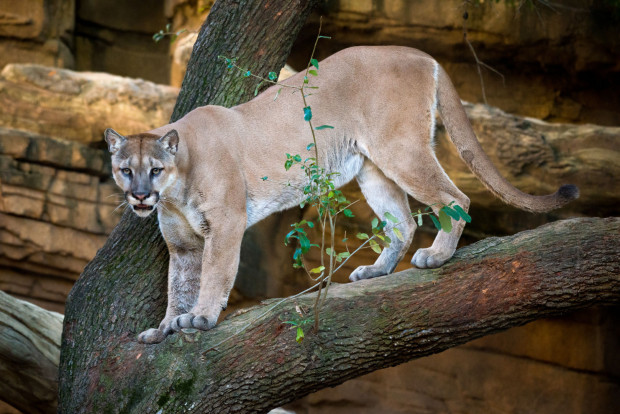

Shasta VI was rescued in 2011 when a hunter illegally shot his mother in Washington. | Courtesy of Stephanie Adams/The Houston Zoo
When Shasta VI was only five weeks old, a hunter illegally shot and killed his mother in Washington.
As a baby cub with no one to guide him in the wild, Shasta’s chances of survival were slim to none. Agents from the Washington Department of Fish and Wildlife rescued him and brought him to his new home in the Houston Zoo in Dec. 2011.
“If it weren’t for zoos like the Houston Zoo who take care of these animals, (Shasta) wouldn’t be here today. He wouldn’t be on this earth,” Houston Zoo public relations director Jackie Wallace said.
Shortly after Shasta’s rescue, UH and the Houston Zoo formed a partnership and officially named the 5-week-old cub the official UH mascot, Shasta VI. Four years later, happy and healthy, Shasta is living life at the Houston Zoo. His primary caretaker, Stephanie Mantilla, said he loves to people watch, play with his enrichment toys and chew on thawed out bones.
“He still has almost a goofy, young boy type personality,” Mantilla said. “Whenever he sees little children running around, he gets very excited, and he will come down and watch them. He’s very playful.”
Shasta’s day typically starts out bright and early at 6 a.m. with a breakfast and training session. His breakfast, which consists of ground-up meat that includes vitamins and nutrients, is made specifically for carnivores and is used as a motivator during his training session.
“The training exercises are all for Shasta to voluntarily participate in his own veterinary care,” Mantilla said. “Some things he has learned how to do are to show the bottom of his teeth, turn around so that we can get a look at his entire body. He’s working on learning how to open his mouth all the way, so we can get a good look at his teeth.”
After the morning training session, Shasta is let back outside for the majority of the day. His only roommate, an older female cougar named Haley, joins him later in the afternoon. After lunch, the two cougars are brought inside so that trainers can clean the exhibit safely and leave enrichment toys for them to find later on.
“The purpose behind (enrichment toys) is so that they will show natural behaviors,” Mantilla said. “It might be interesting scents that they might try to rub on, roll on or even big toy-like things that they can stalk and attack.”
Trainers are always separated by a meshing that allows them to interact with the animals but keeps them at safe distance.

Shasta’s primary caretaker, Stephanie Mantilla, said a protective barrier keeps trainers safe when they are teaching Shasta new behaviors. | Courtesy of Stephanie Adams/The Houston Zoo
“It’s called protective contact, and that means there’s always a protective barrier between us and him,” Mantilla said. “We wouldn’t ever go in with him because even though he was sort of raised around humans, he’s still completely wild.”
Mantilla said lately Shasta has been working on things in front of the exhibit, such as playing on the rock-work table and “showing off his really cool jumping abilities.”
Mantilla said training Shasta is her favorite part of taking care of him.
“If he’s been working on a new behavior, when he finally understands it, you can see kind of a confidence in his behavior,” Mantilla said. “He responds to your tone of voice and everything and he just seems to almost get excited as well, so that’s definitely the most rewarding part.”
After his afternoon training session, Shasta is let out on exhibit for the rest of the day where he lounges on sunny rocks and people watches.
Students, alumni and Houstonians can contribute to Shasta’s care by donating to the Houston Zoo’s adopt program.
“(Shasta as the UH mascot) gives the community a living, breathing representative on a year-round basis,” UH Alumni Association president Mike Pede said. “It’s just a very prideful thing.”
Mantilla said Shasta makes for a perfect ambassador animal because he is so playful and friendly.
“People love coming to watch him and learn about him,” Mantilla said. “I think his specific personality is kind of magnetic in a way. He likes being up at the front of the exhibit where people are, whereas a lot of other cats would stay away.”
Wallace said the zoo’s connection with a local school like UH is a great asset, and she hopes students take advantage of the free admission with student ID they are offered.
“(It’s nice) having a cougar here that we can connect with the students and show them a really amazing animal in their own backyard,” she said.
news@thedailycougar.com
—
“A day in Shasta’s life at the Houston Zoo” was originally posted on The Daily Cougar
